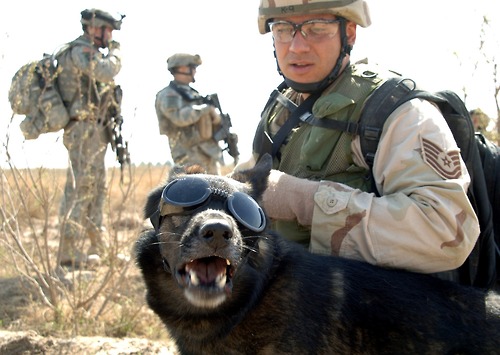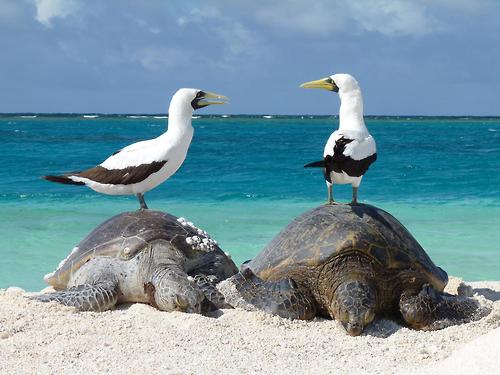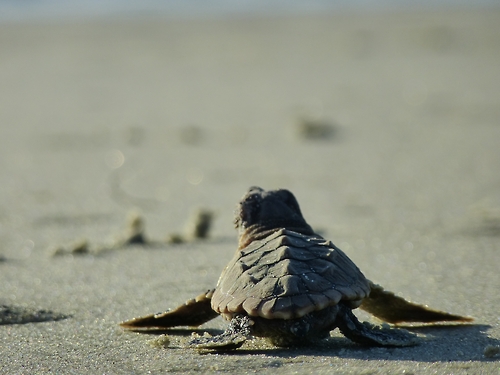Image description: Tech. Sgt. John Mascolo and his military working dog, Ajax, wait for a helicopter pickup outside of Iraq in 2006. Ajax is wearing “doggles” to prevent sand and debris from getting in his eyes.
Photo by Pfc. William Servinski II, U.S. Army
Image description: Two masked boobys stand on the backs of resting sea turtles on the shore of Trig Island, French Frigate Shoals, part of the Papahānaumokuākea Marine National Monument in Hawaii.
The Papahānaumokuākea Marine National Monument is the single largest conservation area under the U.S. flag, and one of the largest marine conservation areas in the world. It encompasses 139,797 square miles of the Pacific Ocean - an area larger than all the country’s national parks combined.
The extensive coral reefs found there are home to over 7,000 marine species, one quarter of which are found only in the Hawaiian Archipelago. Many of the islands and shallow water environments are important habitats for rare species such as the threatened green turtle and the endangered Hawaiian monk seal.
Photo by Mark Sully of the National Oceanic and Atmospheric Administration.
Image description: A loggerhead sea turtle hatchling makes the arduous journey to the ocean on Blackbeard Island National Wildlife Refuge in Georgia. The island provides protection for several endangered and threatened species, such as loggerheads, American bald eagles, and American alligators.
Photo by Becky Skiba, U.S. Fish and Wildlife Service.
Image description: Two Cuban crocodiles hatched at the National Zoo in July, the first in 24 years. Cuban crocodiles are critically endangered, making the babies very valuable. Because temperature during embryonic growth determines the sex of Cuban crocodiles and the existing population is primarily female, zoo keepers carefully incubated the eggs at just around 90 degrees in order to produce males. Learn more about the babies and see more images.
Photo by Barbara Watkins, Smithsonian’s National Zoo
As with the rest of your family, it’s important to plan for your pet before, during and after a natural disaster. While making emergency plans for your family, make sure you know of the pet friendly hotels and shelters in your area, so that if a disaster does occur, you know which places will accept your pet.
You should have an emergency kit planned and ready to go for your family that also includes important things for your pet, like food, medications, veterinary records and other supplies that may not be available later.
If you are evacuated from your home, the Federal Emergency Management Agency (FEMA) suggests that you take your pets with you. Most pets cannot survive on their own if left behind, and if they do, they are often lost after you return to your home.
Making sure your pet has a secure tag with up-to-date information could help your pet be returned to you if you get separated later on.
Learn more about what to do with your pets during and after a disaster.



